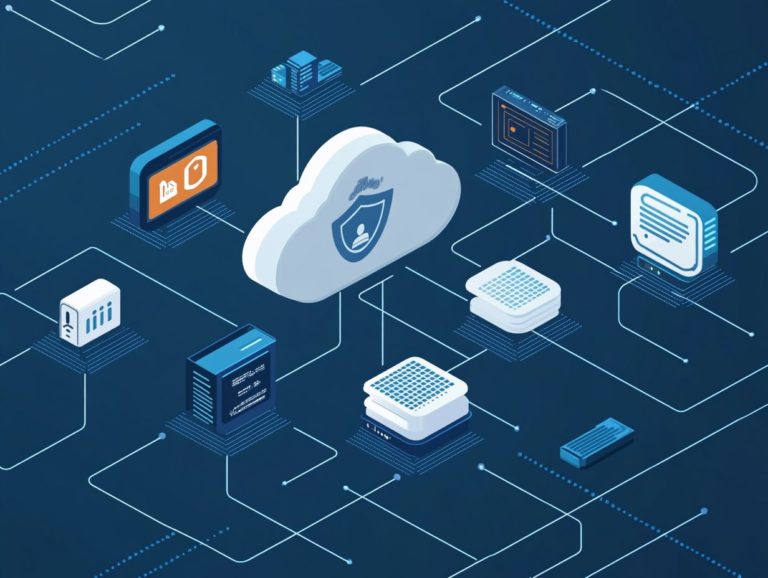The Benefits of Cloud Security Stakeholder Engagement
In today s digital landscape, cloud security is extremely important, and effective stakeholder engagement is essential for safeguarding sensitive information.
This article delves into the significance of involving diverse stakeholders in cloud security. It highlights the benefits they bring and identifies the key players in this critical process.
You will also learn best practices for effective communication and collaboration, along with metrics to measure success. We ll outline actionable strategies for implementing stakeholder engagement.
Explore how you can enhance your cloud security initiatives through meaningful partnerships that drive results.
Contents
- Key Takeaways:
- Defining Stakeholder Engagement in Cloud Security
- The Importance of Stakeholder Engagement
- Key Stakeholders in Cloud Security
- Best Practices for Stakeholder Engagement
- Measuring the Success of Stakeholder Engagement
- Implementing Stakeholder Engagement in Cloud Security
- Frequently Asked Questions
- What is cloud security stakeholder engagement?
- Why is stakeholder engagement important for cloud security?
- Who are the stakeholders in cloud security stakeholder engagement?
- What are the benefits of cloud security stakeholder engagement?
- How can cloud security stakeholder engagement help with compliance?
- Are there any potential challenges to implementing cloud security stakeholder engagement?
Key Takeaways:

Effective engagement with stakeholders is key to strong cloud security. Good communication helps find risks and improve security practices.
Defining Stakeholder Engagement in Cloud Security
Stakeholder engagement in cloud security involves active collaboration with all parties involved in a project this includes organizations, vendors, customers, and regulators.
Together, these groups work to ensure effective risk management and compliance with important standards like GDPR (General Data Protection Regulation), HIPAA (Health Insurance Portability and Accountability Act), and CCPA (California Consumer Privacy Act). This process creates open conversations and builds trust, both of which are vital for achieving successful project outcomes and upholding organizational governance.
The Importance of Stakeholder Engagement
Engaging stakeholders is essential for organizational success in project management. It establishes a solid foundation for effective decision-making and fosters collaboration among a diverse array of stakeholders, including employees, investors, and vendors.
By actively involving stakeholders, you cultivate a sense of accountability and gain insights from various perspectives, ultimately paving the way for innovative solutions and enhanced project outcomes.
Benefits of Involving Stakeholders in Cloud Security
Involving stakeholders in cloud security initiatives brings many benefits, such as forging stronger relationships, minimizing project delays, and boosting cooperation—all essential elements for effectively reducing risks in complex environments. Additionally, understanding the benefits of continuous monitoring for cloud security can further enhance these efforts.
Engaging these groups enhances communication and fosters a transparent dialogue that builds trust. When stakeholders feel valued and heard, they re far more inclined to support initiatives, which helps minimize resistance to change.
This collective cooperation cultivates a more cohesive project environment and strengthens your organizational culture around security.
Ultimately, by addressing the risks associated with cloud vulnerabilities, your projects are more likely to thrive, aligning stakeholder interests with organizational goals and enhancing overall project management efficiency.
Key Stakeholders in Cloud Security

Identifying key stakeholders in cloud security is vital for mastering stakeholder management. These individuals and groups including organizations, regulators, customers, investors, and vendors hold significant power in shaping the security landscape and influencing project outcomes.
Understanding their roles and perspectives is crucial for navigating the complexities of cloud security effectively.
Act now to secure your cloud projects!
Identifying and Understanding Stakeholders
Identifying and understanding stakeholders begins with creating a map of involved parties that captures diverse perspectives and needs in cloud security. This approach drives collaboration and ensures informed project planning.
Your map serves as an essential tool for visualizing relationships and highlighting the expectations of various parties, including technical teams, compliance officers, and end-users.
By organizing this information visually, you can easily identify who holds the most influence or who might be impacted by specific decisions within the project.
Gathering insights from stakeholders is crucial. Their feedback provides invaluable data that shapes effective strategies and mitigates risks. Regular consultations foster a sense of collective ownership of the project, ensuring that all parties feel heard and valued.
This ultimately leads to enhanced cooperation and significantly increases the likelihood of successful outcomes.
Best Practices for Stakeholder Engagement
Implementing best practices for stakeholder engagement is crucial for maintaining transparent communication, fostering collaboration, and enhancing accountability, especially in cloud security projects that might encounter crisis management scenarios.
By prioritizing these practices, you can navigate challenges and build stronger relationships with stakeholders, ensuring everyone is aligned and informed throughout the process.
Effective Communication and Collaboration
Effective communication and collaboration among stakeholders are essential for cultivating strong relationships and amplifying their influence in cloud security initiatives.
To achieve this, implement structured strategies, such as regular updates and feedback mechanisms, to ensure a consistent flow of information. Establishing channels for open dialogue allows stakeholders to share insights and address concerns promptly, fostering a sense of trust that is crucial for success.
Collaboration can significantly advance through joint initiatives, where stakeholders work together on specific projects or tasks. This approach pools resources and expertise, enhancing the quality of contributions while aligning goals more closely.
Ultimately, this creates a robust framework for collective action in cloud security, elevating the effectiveness of your initiatives.
Measuring the Success of Stakeholder Engagement

Measuring the success of stakeholder engagement requires employing specific metrics and indicators that reflect the effectiveness of your communication, collaboration, and overall project outcomes.
This approach enhances accountability in your cloud security initiatives and elevates the overall impact of your efforts.
Metrics and Indicators of Success
Key metrics and indicators of success in stakeholder engagement include stakeholder satisfaction, timely feedback, and the rate of risk reduction. Each of these elements plays a crucial role in elevating project management effectiveness.
These metrics allow you to assess the overall health of a project and provide valuable insights into how well you meet stakeholders’ needs and expectations. High stakeholder satisfaction often reflects effective communication and collaboration, directly correlating with reduced project delays and improved outcomes.
Timely feedback allows you to make necessary adjustments, fostering a more adaptive project environment.
Consider a software development project where regular stakeholder check-ins led to the early identification of potential risks, ultimately reducing those risks by 30%. This proactive approach enhanced team synergy and cultivated a sense of ownership among stakeholders, reinforcing their commitment to the project’s success.
Implementing Stakeholder Engagement in Cloud Security
Implementing stakeholder engagement in cloud security demands a structured approach. Take immediate steps and strategies that cater to the unique needs of each stakeholder.
Emphasizing stakeholder training and facilitating technology adoption ensures a seamless transition and effective collaboration.
Steps and Strategies for Successful Engagement
To engage effectively, follow clear steps and strategies. Weave stakeholder insights into your project planning and execution.
- Start by conducting a thorough stakeholder analysis. Identify the key individuals and groups affected by your project. Understanding their interests and concerns helps tailor your approach to encourage collaboration.
- Next, craft a robust communication plan. Keep all stakeholders informed and engaged throughout the project lifecycle. Regular updates and open channels for dialogue foster transparency and build trust.
- Set up ways for stakeholders to give feedback. This helps them feel involved and fosters collaboration.
These strategies enhance relationships and lead to improved project outcomes. Ensure every perspective is heard and valued!
Frequently Asked Questions

What is cloud security stakeholder engagement?
Cloud security stakeholder engagement is the process of involving all relevant parties, both internal and external, in planning, implementing, and maintaining security measures for a cloud-based system or service.
Why is stakeholder engagement important for cloud security?
Stakeholder engagement is crucial because it ensures that all parties are aware of and involved in the security measures being implemented, leading to more effective and comprehensive security protocols.
Who are the stakeholders in cloud security stakeholder engagement?
Stakeholders can include internal parties like IT teams, developers, and management. They also include external parties such as cloud service providers, third-party vendors, and customers.
What are the benefits of cloud security stakeholder engagement?
Benefits include improved collaboration and communication among stakeholders, increased understanding of security measures and risks, and the ability to identify and address potential vulnerabilities more efficiently.
How can cloud security stakeholder engagement help with compliance?
Involving all relevant stakeholders in security processes helps ensure that all necessary compliance requirements are met, including data privacy regulations and internal security policies.
Are there any potential challenges to implementing cloud security stakeholder engagement?
Potential challenges may include conflicting priorities among stakeholders, difficulty in coordinating schedules, and resistance to change. These can be mitigated by establishing clear roles, setting realistic expectations, and promoting open communication.
Ready to start engaging your stakeholders? Contact us today!






